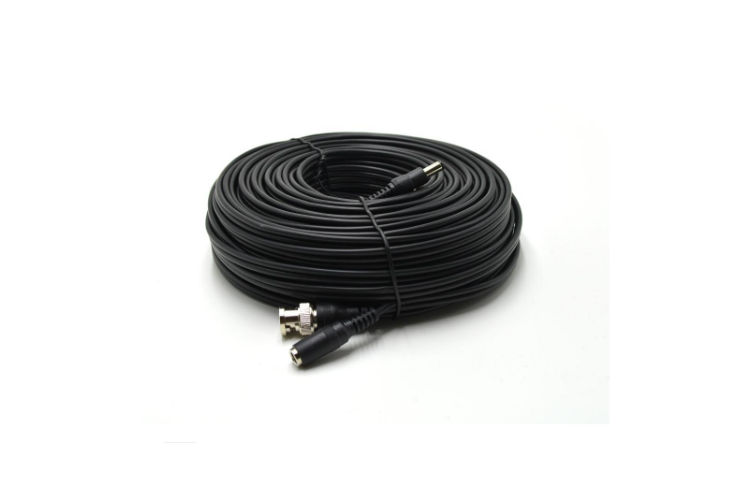CCTV Connectors: Understanding the BNC Connector
The BNC connector (Bayonet Neill–Concelman) is a miniature radio-frequency coaxial connector widely used in CCTV. It features a bayonet locking mechanism – the male plug has two lugs that insert into the female jack and lock with a quarter-turn twist.

This quick-connect design provides a secure, vibration-resistant connection (no screws to work loose). BNCs come in 50?Ω and 75?Ω versions; CCTV systems use the 75?Ω type to match standard video cables and minimize signal loss. In practice, BNCs carry analogue composite video signals (and even certain digital video formats) on RG-59/RG-6 coaxial cable.
The cable end typically has a pre-attached BNC male, and the camera/DVR has the matching BNC female jack. Consumer electronics with RCA video jacks can still connect to professional BNC devices using simple RCA-to-BNC adapters.
The genius of the BNC is its simple push-and-twist action. When you mate a male BNC to a female jack, the lug pins engage and a quarter turn locks it firmly. This bayonet coupling maintains 75?Ω impedance continuity, preserving image quality.
BNC connectors can handle frequencies up to about 2?GHz – well above the bandwidth of CCTV video – which is why they’re used in surveillance, broadcasting and other video applications. In CCTV setups, the cable connector (usually on a camera or pre-made “Siamese” cable) is often crimped or compression-fitted for permanence, while recorder/monitor jacks are fixed on panels.
Types of BNC Connectors
BNC connectors come in several attachment styles, each suited to different installer needs:
- Crimp-On BNC: A 3-piece connector (pin, body and ferrule) that is fitted by sliding onto the stripped cable and crimping with a crimp tool. This method yields a very secure, long-lasting connection – it compresses the cable braid and center conductor firmly into the metal body. Crimp-on BNCs are favored by professionals because once crimped, the shield and center pin are locked in place and won’t pull off. (SecuriCAM’s 10 Pack BNC RG59 Male 3-Piece Crimp Connectors are an example – they require a RG59 crimping tool for attachment.)
- Twist-On BNC: A quick-install style where the BNC slides onto the coax and is simply twisted by hand to lock. No crimping tool is needed – just strip the cable, slide on the connector and tighten by twisting. Twist-on connectors (like SecuriCAM’s 100× BNC Twist Coax Video Connectors) are convenient for DIY or rapid deployments, but they rely on friction to hold the braid. They can work well if installed neatly, but may be less durable than crimped or compression types.
- Compression BNC: A one-piece plug that is fitted with a compression tool. Compression connectors (e.g. SecuriCAM’s CCTV Compression Connector Plug Adapter for RG59/RG6) slide over the cable and are then “crunched” down by a special tool. This creates a very tight, 360° seal around the braid and center pin. Compression BNCs combine the ease of twist-on installation with the security of crimp – they typically maintain shielding continuity better and are more weatherproof. (They are widely used in high-end CCTV for their reliability.)
Each connector type has its place: crimped for highest reliability, twist-on for speed, compression for a middle ground. All maintain the essential 75?Ω impedance of CCTV cable. (In all cases, BNC connectors should be rated for 75?Ω to match RG-59/RG-6 coax.)
Role of BNC Connectors in CCTV Systems
BNC connectors are the standard video link in analogue and HD-over-coax CCTV. On a typical UK surveillance install, each analogue camera outputs video on a coax cable terminated with a BNC male plug, which clicks into a BNC female input on the DVR or a balun. The same applies to older multiplexers, monitors, or any device that handles composite or HD analogue video. For example, RG59 “Siamese” cable has a BNC video plug (plus a DC power plug) at each end, so the camera’s BNC goes to the DVR’s BNC input. Popular HD-over-coax standards (HD-SDI, AHD, HD-CVI/TVI) also use 75?Ω BNC connectors on RG-59 or RG-6 cables, since they send high-definition video using the same coaxial infrastructure.
Key roles of BNCs in CCTV:
- Analog Video Transmission: In traditional CCTV (PAL/NTSC), BNC connectors carry the composite video (0.5?Vp–p at 75?Ω) between camera and recorder. They ensure the analogue signal is shielded from noise over long cable runs.
- High-Definition Coax: Even as CCTV evolved, cameras like 1080p AHD or 4MP HD-CVI still use BNC-to-BNC cabling. These HD signals are just higher-frequency analog waveforms, so the same 75?Ω BNC system works. (Indeed, 75?Ω BNCs are specified for HD video applications.)
- Flexible Installation: CCTV wiring often needs to run tens or hundreds of meters. BNC connectors allow installers to terminate coax on-site (using crimp/compression) or use pre-assembled cables. They mate/demote quickly during maintenance or expansion.
- Adaptability: If a building upgrades cameras, the existing BNC cabling can often be reused. For example, a purely analogue system using BNCs can be adapted to support HD-SDI by swapping cameras and DVR but keeping the same RG-59 wiring.
In summary, in UK CCTV installations the BNC is the de facto video connector. Systems from basic home CCTV to complex commercial setups rely on it for reliable video feed. (The DVR or NVR’s video inputs are nearly always BNC for analog systems.) For completeness, note that power and audio use different connectors (e.g. 2.1?mm DC plugs or Phoenix blocks) – but the video itself is almost always BNC on coax.
Benefits of BNC Connectors in CCTV
Using BNC connectors in CCTV offers several advantages:
- Secure, Reliable Connection: The quarter-turn bayonet lock ensures the plug stays firmly in place. Installers praise BNCs for their durability and low risk of signal loss or dropout. Once locked, they resist vibration and cannot pull loose, unlike simple RCA plugs.
- Consistent Impedance: By design, a good BNC maintains the 75?Ω impedance of the cable all the way through the connector. This minimizes reflections and preserves video quality over long cable runs. In CCTV, where runs of 50–200?m are common, this is crucial for a clear picture.
- Signal Integrity: BNC’s metal body and full braid contact provide excellent shielding. As one security cable guide notes, they “ensure a stable connection” and “exceptional signal integrity” for video. This translates to sharper, stable surveillance images.
- Versatility: BNCs work with different coax types (RG-59, RG-6) and can carry any analogue video format. There are even mini-BNC variants (HD-BNC) for high-density racks, proving the design’s adaptability.
- Ease of Installation: Even though many connectors use tools, the bayonet principle is easy. Twist-on BNCs require no tool. For crimp or compression types, installers often have dedicated crimpers or compression tools, but once learned, these connectors are quick to fit. Many DIYers can also use simple twist-on BNCs for quick fixes.
Each advantage helps meet CCTV requirements: fast setup, reliable footage, and easy maintenance. In fact, CCTVTek highlights that BNC “quick and secure connection” and “durability” make it ideal for video applications.
Limitations of BNC Connectors in CCTV
No connector is perfect. BNCs have some limitations:
- Requires Power Off to Connect: BNCs are not hot-swappable. You should turn off power (or at least stop signal) when connecting/disconnecting BNCs to avoid arcing or static noise. This means planned maintenance or system shutdowns for changes.
- Size and Bulk: BNC connectors are relatively chunky compared to something like RCA or mini connectors. In tight or concealed installations (e.g. in-wall hidden cameras), their larger size can be a drawback. Their metal bodies also make them heavier – a factor in very long cables.
- Installation Tools (for Best Performance): To achieve the most reliable joints, crimp or compression tools are needed. Twist-on BNCs can be done by hand but are mechanically weaker. A poorly crimped connector can fail or increase signal loss. (However, twist-on types sacrifice some performance for convenience.)
- Analog-Only (Basic BNC): Standard BNC connectors themselves carry analog or serial-digital composite signals. They cannot directly carry an IP/network signal or HDMI; modern systems requiring network or ultra-high-definition signals will use different connectors (see below).
- Cable Length Limits: While not a fault of the connector per se, analogue BNC links suffer from cable attenuation. On RG-59 with BNC ends, reliable video might only reach ~200–300?m before picture degrades. Beyond that, repeaters or digital conversion (e.g. to fiber) are needed.
Overall, BNCs offer high signal quality but at the cost of being larger and requiring proper termination. Installers mitigate this by using high-quality crimped connections or compression fittings and planning cable runs within effective distances.
Comparing BNC to Other CCTV Video Connectors
Surveillance systems also use various other connectors. Here’s how BNC stacks up:
- RCA (Phono) Connector: RCA is the simple push-fit plug often seen on cheap VHS cameras or white video ports. RCAs are hot-pluggable and very easy to use – just push them in. They are inexpensive and common on low-end CCTV gear. However, an RCA on a coax has no locking mechanism – it can pull out easily and offers less shielding. Consumer advice notes that RCA is “less secure than BNC” and prone to signal loss. BNC connectors provide a metal lock and better 360° contact. (If you have a BNC-only DVR and an RCA camera, you can use a simple RCA-to-BNC adapter to mate theme, though the connection is still as weak as an RCA.)
- HDMI Connector: HDMI is a digital high-definition interface used to connect DVRs/NVRs to monitors. Unlike coax/BNC, HDMI carries compressed digital audio/video on a ribbon cable. In CCTV, HDMI is not used on cameras; instead, it’s common on recorders/monitors for viewing footage. HDMI supports resolutions up to 4K and beyond, which far exceed analogue limits. In practice, you would use HDMI to link your DVR to a TV screen, not between camera and DVR. An installer might convert a DVR’s BNC output to HDMI for a modern display. Unlike BNC, HDMI cables have shorter maximum lengths (typically <15?m without boosters) and are more expensive. They also cannot run power. Essentially, HDMI is complementary – it’s the “last leg” from recorder to screen, while BNC is used camera→DVR.
- Ethernet (RJ45): IP cameras use Cat5e/Cat6 network cables with RJ45 plugs instead of coax. An RJ45 carries digital video (via IP/PoE) and can also supply power (PoE). Its bandwidth can handle multiple cameras (Gigabit and up), whereas one coax/BNC link is one video channel. If using IP cameras, BNC connectors and coax are bypassed entirely. Ethernet’s advantages (high resolution, flexibility, PoE) are at the cost of complexity (network setup) and usually higher cable costs. In summary, BNC over coax is analogue and point-to-point, while RJ45 is digital and networked. Modern UK systems often mix both: e.g. using BNC coax for older analogue cameras, and RJ45 for newer IP cameras on the same site.
In short, BNC connectors excel for classic analogue video and simple HD-over-coax links. RCA connectors are cheaper but less robust. HDMI and network cabling serve modern digital workflows. The choice depends on system type: if your cameras are analogue, BNC is generally best; if IP cameras are used, you’ll rely on RJ45 instead.
Recommended CCTV Connector Products
For UK installers and DIYers, SecuriCAM Wholesale offers a range of practical CCTV connectors (all used with 75?Ω cables). Here are some examples:
- 10 Pack BNC RG59 Male 3-Piece Crimp Connectors – A set of 10 crimp-on BNC plugs for RG59 coax. Each connector is three parts (body, pin and ferrule) and requires a crimping tool for installation. These are ideal for creating custom CCTV cable runs: you strip an RG59 cable, slide on the parts and crimp the ferrule to lock the braid. Once crimped, they provide a solid, professional-grade connection.
- 100× BNC RG59 Male 3-Piece Crimp Connectors – Same type as above but in bulk (100 pack). Useful for large installations or resellers. You’ll get a lot of BNC plugs for a low unit price. Again, they give a very secure fit when crimped properly.
- 100× BNC Twist Coax Video Connectors (Male RG59) – These twist-on BNC connectors screw onto RG59 without a crimp tool. Each simply slides over the stripped cable end and twists to tighten. They are quick for splices or test setups. (Note: because they rely on friction, make sure the braid is cleanly folded back for best contact.) These are great for DIY projects or temporary fixes.
- CCTV Compression Connector Plug Adapter (RG59/RG6)– A pack of compression-style BNC plugs designed for RG59 or RG6. You attach the plug and use a coaxial compression crimper to lock it down. This yields a neat, weather-resistant joint – ideal for outdoor or professional installs. Compression connectors maintain perfect cable shielding and pin alignmentt. (For these, you’ll also need a compression tool, e.g. SecuriCAM’s crimping tools.)
- 10 Pack 12V DC Male Power Connectors (2.1mm)– While not a BNC, this 12V DC jack is the standard power connector for CCTV cameras. In coaxial (siamese) cables, video and power run together: the video uses BNC and the camera’s DC input uses a 2.1×5.5?mm jack. These male DC plugs fit into a camera’s power socket and mate with the female on the cable. They come in nickel-plated brass to resist corrosion, suitable for harsh UK weather.
- (Other connectors): SecuriCAM also stocks RCA plugs, DC/DC adapters, and RJ45 keystone jacks in the CCTV connectors category – all useful for various surveillance setups. For example, RCA connectors are often used on DVR audio inputs (if any), and insulated DC plugs (2.1?mm or 2.5?mm) supply camera power. While our focus is BNC here, it’s good to remember that a complete CCTV install will use a mix of BNC and power connectors, and SecuriCAM carries all these items.
Each of the above products is sold by a UK-based supplier (SecuriCAM, West Yorkshire) and is CE-compliant for UK installations. They are the kinds of parts used by CCTV professionals in the UK for both home and commercial systems.
Choosing the Right CCTV Connectors
In summary, BNC connectors are the backbone of analogue and HD-over-coax CCTV. Their quick-lock bayonet and impedance matching make them well-suited for carrying security video with high fidelity. When planning or upgrading a UK CCTV installation, remember:
- Match the cable: Use 75?Ω BNC connectors on 75?Ω coax (RG-59/RG-6). Mismatched connectors can spoil the signal.
- Pick the connector type: For permanent installs, crimp or compression BNCs give the best performance. For temporary or quick jobs, twist-on is acceptable.
- Consider your system: If using analogue cameras or HD-SDI/AHD/CVI, BNC is the right choice. If deploying IP cameras, you’ll use RJ45 instead. For connecting DVRs to monitors, use HDMI or VGA.
- Follow UK standards: Although there is no unique UK “BNC standard,” all equipment sold in the UK must meet CE/UKCA requirements. Use quality connectors from reputable suppliers (like SecuriCAM) to ensure compliance and reliability. British engineers often follow BS EN 62676 (CCTV standards), which stresses good image quality – something that proper connectors help achieve.
By understanding what a BNC connector is and how it compares to alternatives, installers and hobbyists can make informed choices. In the CCTV industry, using the correct CCTV connectors is vital – it determines how good your footage will look and how robust the system is. Whether it’s a small DIY home setup or a large commercial installation, the right BNC connector (and proper termination) is key to clear, dependable surveillance video.











